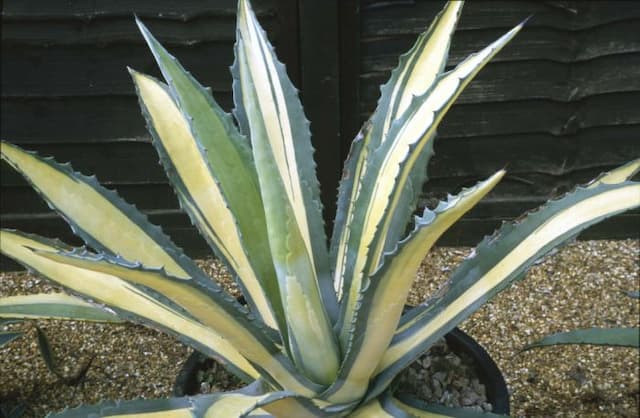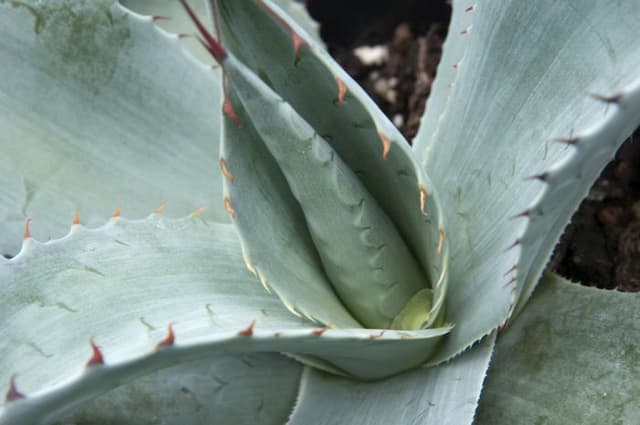Plantain Lily Hosta 'Paul's Glory' (v)

ABOUT
Hosta 'Paul's Glory' is a striking perennial known for its foliage, which has a unique coloration and pattern. The heart-shaped leaves are large and have a prominent vein structure. The center of each leaf showcases a radiant gold or chartreuse hue. This vibrant center is beautifully contrasted by irregular blue-green margins, creating a dramatic visual effect in the garden. As the seasons change, the gold in the leaves may deepen, enriching the display. During the bloom period, Hosta 'Paul's Glory' produces tall flower scapes that are adorned with funnel-shaped flowers. The blooms tend to be a lavender or pale violet color, which adds a soft touch of floral interest against the bold backdrop of the variegated leaves. This hosta variety is celebrated not only for its foliage but also for these delicate blossoms that rise above the foliage and attract pollinators such as bees and hummingbirds. Overall, Hosta 'Paul's Glory' offers a lush and vibrant appearance that provides an eye-catching display in shaded garden areas.
About this plant
 Names
NamesFamily
Hostaceae
Synonyms
Plantain Lily, Funkia
Common names
Hosta 'Paul's Glory'
 Toxicity
ToxicityTo humans
Hostas, including the variety 'Paul's Glory', are generally considered to be non-toxic to humans. There is no significant evidence to suggest that ingesting them would result in poisoning or serious health complications. That said, ingestion of any non-food plant can potentially cause mild stomach upset or an allergic reaction in some individuals.
To pets
Hostas are known to be toxic to pets, particularly dogs and cats. If ingested, they can cause symptoms of poisoning which may include vomiting, diarrhea, and in more severe cases, depression. It is advised to keep pets away from these plants and to seek veterinary attention if you suspect your pet has ingested any part of a hosta plant.
 Characteristics
CharacteristicsLife cycle
Perennials
Foliage type
Deciduous
Color of leaves
Variegated
Flower color
Lavender
Height
1-3 feet (30-90 cm)
Spread
3-6 feet (90-180 cm)
Plant type
Herb
Hardiness zones
3
Native area
Asia
Benefits
 General Benefits
General Benefits- Attractive Foliage: Hosta 'Paul's Glory' is known for its beautiful variegated leaves that provide aesthetic appeal to any garden.
- Shade Tolerant: It thrives in shady areas where many other plants struggle, making it ideal for woodland gardens or dim spots.
- Easy to Grow: This Hosta is low maintenance and can easily adapt to a variety of soil conditions, requiring minimal care.
- Seasonal Interest: It offers a long season of interest, from its spring foliage emergence to its late summer flowers.
- Ground Cover: Its dense growth habit helps to suppress weeds, reducing garden maintenance tasks.
- Drought Resistance: Once established, Hosta 'Paul's Glory' is quite drought-tolerant, making it suitable for gardens with less frequent watering.
- Winter Hardiness: It is a hardy perennial that can survive cold winters, making it suitable for a variety of climate zones.
- Wildlife Attraction: The flowers of Hosta 'Paul's Glory' attract pollinators, such as bees, adding to the ecological value of the garden.
- Variety of Uses: It can be used in a range of landscape designs, including borders, containers, and as a focal point in a shade garden.
- Dividable: As the plant matures, it can be divided to create additional plants, providing a cost-effective way to expand your garden or share with friends.
 Medical Properties
Medical PropertiesThis plant is not used for medical purposes.
 Air-purifying Qualities
Air-purifying QualitiesThis plant is not specifically known for air purifying qualities.
 Other Uses
Other Uses- Hosta leaves can be used in floral arrangements, where their large and colorful foliage adds a robust and attractive contrast to delicate flowers.
- The large leaves of the Hosta plant can be used as a natural "wrap" for outdoor dining, lending a festive and eco-friendly touch to picnics and barbecues.
- Hosta plants are sometimes used in container gardens to provide a lush, full appearance and to complement flowering plants with their varied leaf patterns.
- The plant can be grown as a living mulch under trees or shrubs, helping to retain soil moisture and prevent weed growth.
- Hosta foliage can be creatively incorporated into crafting, such as making leaf-imprinted clay dishes or concrete stepping stones for gardens.
- They can serve as a natural dye source; the varying shades of green in the leaves can produce subtle dye colors on fabrics.
- In garden design, Hostas can be used to create texture contrasts with grasses, small-leaved plants, or ferns due to their broad foliage.
- Hosta blooms, which are often overlooked, can be cut and floated in shallow bowls of water as a unique aquatic floral display.
- The Hosta can be used as an indicator plant; when its leaves start to wilt, it shows that the garden needs watering without expensive moisture meter tools.
- During Hosta maturity, when flower stalks are cut, they can be used as natural supports for other floppy plants in the garden.
Interesting Facts
 Feng Shui
Feng ShuiThe Hosta is not used in Feng Shui practice.
 Zodiac Sign Compitability
Zodiac Sign CompitabilityThe Hosta is not used in astrology practice.
 Plant Symbolism
Plant Symbolism- Resilience and adaptability: Hostas are known for their hardy nature and ability to thrive in a variety of environments, suggesting these personal qualities.
- Longevity: With proper care, these plants can live for many years, symbolizing endurance and the passage of time.
- Prosperity: The lush foliage of the Hosta can symbolize growth and abundance in one's life.
- Opportunistic: Hostas can prosper in shaded areas where other plants might struggle, representing the ability to find opportunities in challenging conditions.
- Peace and tranquility: Hostas are commonly found in serene and shaded garden settings, often associated with peacefulness and calmness.
- Heartfulness: The heart-shaped leaves of many Hosta varieties, such as 'Paul's Glory,' may symbolize the giving and receiving of love.
 Water
WaterFor the Hosta, commonly known as plantain lily, water thoroughly about once a week to maintain evenly moist soil, particularly during dry spells. They prefer about an inch of water a week, either from rainfall or irrigation. If using a hose, allow water to gently soak the soil around the roots without leaving the plant soggy, which can encourage root rot. During very hot periods, water may be needed twice a week. Adjust the watering frequency to decrease in the fall as the plant prepares for dormancy.
 Light
LightThe Hosta, or plantain lily, thrives best in conditions where it can receive morning sunlight and afternoon shade. The ideal spot for it is in a garden that provides filtered sunlight or partial shade, as too much direct sunlight can scorch its leaves. While it is tolerant of a range of light conditions, its colors are most vibrant when it's protected from the harsh afternoon sun.
 Temperature
TemperatureHostas, including 'Paul's Glory,' grow well in temperatures ranging from 50°F to 85°F. They can survive minimum temperatures down to about 30°F, but frost can damage the leaves. Ideally, maintain a temperature above freezing to ensure healthy growth. Avoid exposure to extreme heat above 90°F, which can stress the plant.
 Pruning
PruningPruning of the Hosta, also known as plantain lily, mainly involves removing dead or damaged foliage to promote healthy growth and maintain an attractive appearance. Prune away spent flower stalks after blooming to allocate energy to the leaves. In early spring or late fall, cut back the entire plant close to ground level to prepare for new growth or winter dormancy.
 Cleaning
CleaningAs needed
 Soil
SoilHostas thrive in a well-draining, fertile soil mix rich in organic matter with a pH between 6.0 and 7.5. A blend of loamy garden soil, compost, and a small amount of sand or perlite to improve drainage can create an optimal environment for 'Paul's Glory' Hostas.
 Repotting
RepottingHostas typically do not need frequent repotting, but 'Paul's Glory' Hostas should be checked every 3-4 years. They may need repotting if the root system has outgrown the container or the soil has degraded.
 Humidity & Misting
Humidity & MistingHostas prefer a moderate level of humidity, though they are quite adaptable. 'Paul's Glory' Hostas will thrive in an environment that replicates the natural humidity of an outdoor garden, which is generally around 40-60%.
 Suitable locations
Suitable locationsIndoor
Provide bright, indirect light and keep the soil moist.
Outdoor
Plant in partial shade, keep soil moist, and mulch.
 Life cycle
Life cycleHosta 'Paul's Glory', commonly known as plantain lily, begins its life cycle as a dormant rhizome or division planted in the ground in either early spring or fall. The rhizomes sprout into clumps of broad, often variegated leaves that unfurl as temperatures warm in the spring. Throughout the summer, the plantain lily enters its vegetative stage, with leaves reaching full size and the plant focusing on photosynthesis and energy storage in the rhizome. In mid to late summer, flower scapes emerge, bearing lavender or white blooms that attract pollinators. After flowering, the plant gradually prepares for dormancy as fall approaches, with foliage dying back after the first few frosts. The dormant rhizome remains underground during winter, conserving energy to restart the cycle in the following spring.
 Propogation
PropogationPropogation time
Late spring to early summer
The Hosta 'Paul's Glory', commonly known as Hosta, is best propagated through division, which is most effectively done in the spring as the new shoots, or "eyes," are just beginning to emerge from the soil. To propagate by division, the plant should be carefully dug up and the soil removed from the roots. Using a sharp knife or spade, the clump is then divided into smaller sections, ensuring that each section has at least two or three shoots and a portion of the root system attached. These divisions can then be replanted at the same soil depth they were previously growing, spaced approximately 30 inches (approximately 76 centimeters) apart to allow for future growth. New divisions should be watered thoroughly and kept moist as they establish themselves in their new location.



![Beschorneria [Flamingo Glow]](https://whatplantisthis.io/_next/image?url=https%3A%2F%2Fplants-admin.emdemapps.com%2Fimages%2Fplants%2F%2Fimages%2F604b59df2e78d.png&w=640&q=75)




